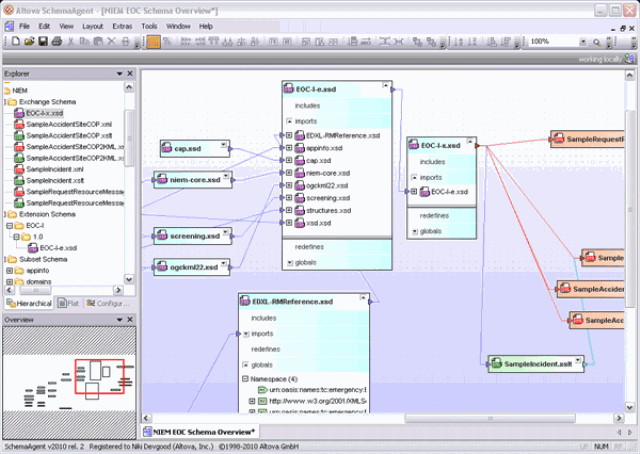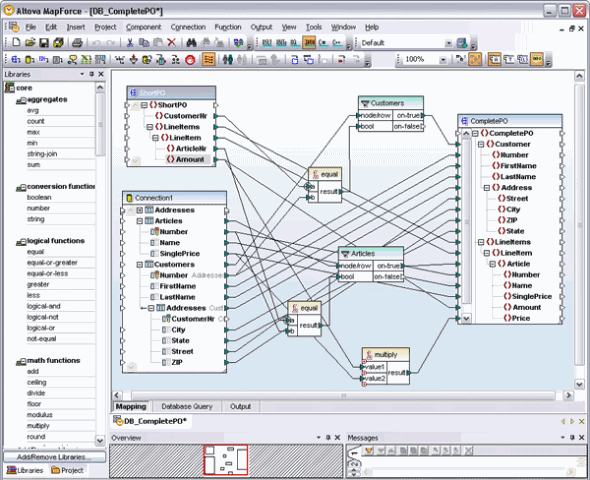Altova Adds to NIEM Support in v2010r3
Clashes between government agencies are the stuff of legends and entire TV shows: the FBI and the CIA, the local sheriff’s department and the big city CSI, Homeland Security and the Pentagon, Jack Bauer and CTU. Perhaps this has to do with the territorial nature of some of these entities, but perhaps, just perhaps, technology has a part to play in these conflicts. Incompatible architectures and data formats, legacy systems, and other technology road blocks within the United States government sometimes made it difficult for agencies to efficiently share pertinent information such as arrest reports, amber alerts, immigration details, and more.
The National Information Exchange Model (NIEM) is an XML-based standard for data exchange between United States government agencies and their information partners. It aims to provide a means for these entities to improve decision making, achieve greater operating efficiency, mitigate risk, improve public safety, and increase ROI through intergovernmental information exchange.
As a leader in XML tools and technologies, the Altova MissionKit already inherently supports NIEM on a variety of different levels. In v2010r3, we added two very specific features to XMLSpy that extend the XML editor with capabilities that are invaluable for NIEM development. For more on these features, see the recent NIEM blog post by our CEO and XML Aficionado, Alexander Falk.
Below is a brief overview of the support provided for NIEM across the MissionKit, from XML Schema editing in XMLSpy, to XMI import and UML diagramming in UModel, to data integration in MapForce, and beyond.
XMLSpy
XMLSpy® 2010 provides a graphical schema design interface which simplifies the development of XML Schemas, allowing XML code to be generated in real-time behind the scenes. Users can switch back and forth between this view and text view at any time during their design process.
The graphical schema editor provides built-in support for creating the IEPD Extension Schema, Constraint Schema, and Exchange Schema.
 | |
In addition to the broad XML Schema support described above, XMLSpy provides comprehensive support for all other prevalent XML technologies, including:
- Graphical and text-based editing views
- Sophisticated XML Schema and XML instance validation
- XML instance document creation
- XSLT editor, debugger, and profiler
- Web services tools (WSDL editor, SOAP client, SOAP debugger)
UML Diagrams
The first stage in any development lifecycle is a thorough business requirements review. UML is particularly well-suited to modeling software projects because it provides a standardized approach to the design process. Scenario-based planning is recommended for NIEM, and though there is no UML diagram requirement, class diagrams, use-case diagrams, and sequence diagrams all provide value to IEPD documentation. In addition, NIEM provides a free tool for mapping data requirements based on an uploaded XMI representation of a UML model
UModel® 2010 is an advanced UML tool that supports all fourteen UML 2.3 diagrams, BPMN, SysML, and more. It works seamlessly with XML technologies like XMI, letting users easily import and export XMI based on their UML diagrams. UModel can even render XML Schemas in a format similar to UML diagrams and integrates seamlessly with all other MissionKit tools including XMLSpy, MapForce, and SchemaAgent. UModel also supports code generation, round-trip engineering, and reverse engineering, as well as integration with the popular Visual Studio and Eclipse IDEs.
UModel can be used two different phases of NIEM development:
- Scenario Planning – to model and document with use case diagrams, sequence diagrams, and business process modeling
- Map & Model – to develop class diagrams to create the exchange content model
 | |
XML Schema Management
Because of the potential to have many different schemas in each IEPD, XML Schema management can become an arduous process. SchemaAgent® 2010 is a unique file management tool that lets users visually manage their XML Schema, XML, XSLT, and WSDL assets in a project-based environment so that changes and structure of the file configuration can be easily recognized. SchemaAgent users can even view mapping files created using MapForce.
 | |
Data Mapping & Exchange
Data mapping is a crucial step at several levels in the NIEM process. Mapping helps users generate a subset schema to determine what elements can be used from the core and domain models, it is also used to perform a transform from one NIEM vocabulary to another. Some NIEM implementations also employ Web services to provide a mechanism for the exchange.
MapForce® 2010 is an any-to-any data mapping and integration tool that supports all of the potential data formats used in the NIEM lifecycle including XML, databases, flat files, Excel 2007+, and Web services. MapForce maps data based on its underlying structure (i.e. XML Schema), enabling mapping designs to be reused for recurrent transformations. MapForce also supports mapping to and from multiple source or target components. In addition, MapForce can be used to generate documentation detailing mapping projects for non-technical stakeholders in a variety of formats such as HTML and Microsoft® Word.
 |
To try out this functionality on your own, download a free 30-day trial of Altova MissionKit now!

NIEM page is missing…
I would like to develop NIEM web services.
Can your product generate C# source code to marshal and unmarshal the information for a NIEM-based web service?
Thank you for the heads-up about that link! I have fixed it now. You can find some good, up to date info on working with NIEM data here: http://www.altova.com/xmlspy/schema-flattener-subset.html
Yes, you can use MapForce, also available in MissionKit, to autogenerate C# Web services code: http://www.altova.com/mapforce/build-web-services.html